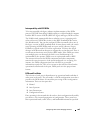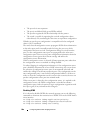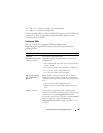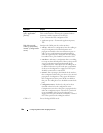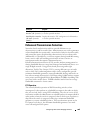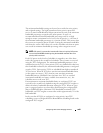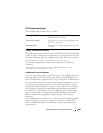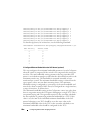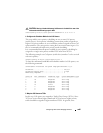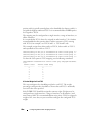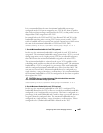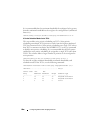
Configuring Data Center Bridging Features 1001
The minimum bandwidth setting can be used to override the strict priority
and weighted settings. The highest numbered strict priority queue will
receive no more bandwidth than 100 percent minus the sum of the minimum
bandwidth percentages assigned to the other queues. If used, it is
recommended that minimum bandwidth percentages only be set high
enough to ensure a minimum level of service for any queue; i.e., the sum of
the minimum bandwidth percentages is a fraction of 100%. This ensures that
the system can respond to bursts in traffic. Setting the minimum bandwidths
such that they sum to 100% effectively sets the scheduler such that no queue
can exceed its minimum bandwidth percentage when congestion occurs.
Each CoS queue in the first level scheduler is mapped to one of the three
traffic class groups in the second level scheduler. There, frames are serviced
using the TCG configuration. The minimum bandwidth guarantee is first
calculated across the TCGs. Strict priority TCGs are scheduled first but have
their bandwidth reduced by the minimum bandwidth guarantees configured
on other TCGs. Strict priority TCGs are scheduled from highest numbered
TCG to lowest. When all TCGs have met their minimum bandwidth limits
(or the queues are empty), TCGs that have not met their maximum
bandwidth limit are scheduled. Once the limits for a TCG are satisfied
(maximum bandwidth, no frames available for transmission, etc.), the
scheduler moves to the next TCG.
If no minimum or maximum bandwidth limits are configured, TCGs are
serviced by the second-level scheduler using the configured TCG weights to
define the relative bandwidth allocation among the TCGs. When an egress
port is congested, packets are selected for discard using the configured tail-
drop or WRED discipline. Minimum TCG bandwidth, maximum TCG
bandwidth, and TCG weights are metered to within approximately 3% of the
link bandwidth.
In the case that all TCGs are configured as strict priority, inter-TCG
scheduling reverts to Weighted Deficit Round Robin scheduling based on the
configured TCG weights.
NOTE: CoS queue 7 is reserved for internal traffic. Non-strict priority CoS queues
are serviced with WDRR scheduling using the bandwidth available after strict
priority traffic is serviced.



